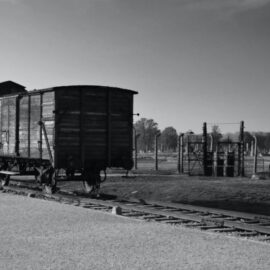
We’ve put together discussion questions for Unbroken by Laura Hillenbrand that you can use with a book club, a class at school, or a team at work. We include sample answers, book club activities that will help you get more out of what you’ve read, and recommendations for more reading if you like this book.
Table of Contents
Book Synopsis
Unbroken tells the extraordinary true story of Louis Zamperini, an Olympic runner turned World War II bombardier. After his B-24 plane crashed into the Pacific Ocean in 1943, Zamperini and two crewmates survived 47 harrowing days adrift on a life raft, enduring starvation, dehydration, shark attacks, and enemy strafing. Just when rescue seemed impossible, they reached land—only to be captured by the Japanese navy.
Zamperini’s ordeal intensified as he spent more than two years in brutal Japanese POW camps, where he faced systematic torture and degradation, particularly at the hands of a sadistic guard nicknamed “The Bird.” Through sheer resilience and determination, he survived the war, though he returned home deeply traumatized. The book follows his postwar struggles with PTSD and alcoholism—and ultimately his journey toward forgiveness and redemption after a spiritual awakening. Hillenbrand’s narrative is a testament to the strength of the human spirit in the face of unimaginable suffering.
Read Shortform’s comprehensive guide to this book.
Unbroken Discussion Questions & Sample Answers
Along with discussion questions for Unbroken, we include sample answers you can use as prompts.
- What role did Zamperini’s difficult childhood and early delinquency play in preparing him for his later ordeals?
- Sample answer: I think his rebellious streak actually saved him in a way. He was already used to being an outsider and fighting against the odds. So, when he faced those impossible situations during the war, he had that same defiant attitude. He wasn’t going to let anyone break him, whether it was the neighborhood kids or a Japanese prison guard.
- How did Hillenbrand portray the experience of being adrift at sea, and what surprised you most about the 47 days on the raft?
- Sample answer: What really got me was how she described the mental deterioration alongside the physical suffering. I expected the starvation and thirst to be awful, but I hadn’t thought about how the boredom and hopelessness would be almost as torturous. The fact that they caught rainwater and birds with their bare hands and still barely survived really showed how close to the edge they were.
- Why do you think “The Bird” (Mutsuhiro Watanabe) singled out Zamperini for such brutal treatment?
- Sample answer: I think it was partly envy. Zamperini was this famous Olympian, and The Bird was this failed person who couldn’t live up to his family’s expectations. He saw Zamperini as someone who represented everything he wasn’t, so he wanted to destroy him. It was as though he was trying to prove his own power by breaking someone remarkable.
- How does the book explore the theme of resilience? What are the different sources of strength that sustained Zamperini?
- Sample answer: Zamperini drew strength from so many places—his competitiveness, his stubbornness, his memories of family and running. But I think what really kept him going was spite, honestly. He refused to give his captors the satisfaction of seeing him broken. Later, of course, he needed different kinds of strength to deal with his PTSD, which was almost harder.
- What do you think about the contrast between Zamperini’s survival during the war and his struggles after returning home?
- Sample answer: That was one of the most powerful parts of the book for me. Here’s this guy who survived impossible physical torture, but then he comes home and nearly destroys himself with alcohol and rage. It showed that surviving trauma isn’t just about the moment; it’s about what comes after. The war didn’t end for him just because the actual war ended.
- How did Hillenbrand handle the depiction of Japanese culture and the POW guards? Do you find her portrayal balanced?
- Sample answer: I thought she tried to provide context about the Japanese military culture and how brutal it was even to its own soldiers, which helped explain—though not excuse—some of the treatment. She also showed guards who were less cruel, so it wasn’t completely one-sided. But, honestly, some of those scenes were so horrific that it was hard to think about nuance while reading them.
- What role did forgiveness play in Zamperini’s eventual recovery, and does his journey toward forgiving his captors seem believable to you?
- Sample answer: At first, I was skeptical because his transformation seemed almost too dramatic. But the way Hillenbrand described how the hatred was consuming him, destroying his marriage and his life, I could see why he needed to let it go for his own sake. It wasn’t really about excusing what happened to him; it was about freeing himself from being a prisoner of his own rage.
- How did Zamperini’s experience as an Olympic athlete prepare him—or fail to prepare him—for his wartime experiences?
- Sample answer: The athletic training definitely gave him physical endurance and mental toughness—that ability to push through pain that runners develop. But I don’t think anything could really prepare someone for that level of brutality and powerlessness. Running was something he chose and controlled; the war stripped away all his control. Though I guess his competitive nature helped him see survival as a race he was determined to win.
- What do you think about the level of detail Hillenbrand included about the violence and suffering in the POW camps?
- Sample answer: Some of it was really hard to read, I’ll be honest. There were moments I had to put the book down. But I think she included those details because anything less would have been sanitizing the truth. We need to understand what Zamperini actually endured to appreciate his survival and his later struggles. It felt respectful to the reality of what happened rather than gratuitous.
- How does the book explore the idea of dignity in impossible circumstances?
- Sample answer: That scene where Zamperini refuses to look at The Bird, or when the prisoners find little ways to resist—those moments really stuck with me. Even when they had nothing, couldn’t control anything about their situation, they found tiny ways to assert their humanity. It reminded me that dignity isn’t something that can be taken away—only something you can choose to surrender, and Zamperini never did.
- What role did others (Phil, Mac, and the other POWs) play in Zamperini’s survival?
- Sample answer: Phil was absolutely crucial. Having someone else to care about, to plan with, to share the burden with—that made a huge difference. Even Mac, who ate the chocolate and seemed like a liability, represented something important about the randomness of who survives. And the solidarity among the POWs (even in small gestures) showed how human connection can sustain you when everything else is gone.
- How effective is Hillenbrand’s writing style in telling this story? What techniques stood out to you?
- Sample answer: She has this incredible ability to build tension even when you know the outcome—I mean, obviously Zamperini survived since he talked to her for the book! But I was still on the edge of my seat during the raft scenes. She also doesn’t editorialize much; she lets the facts speak for themselves, which somehow makes it even more powerful. The research is meticulous but never feels dry.
- What does the book reveal about the American government’s treatment of returning POWs and their mental health needs?
- Sample answer: It’s pretty damning, I think. They basically received no psychological support, no recognition of what we now call PTSD. They were just expected to come home and act as though nothing happened. Zamperini was having violent nightmares and flashbacks and drinking himself to death, and there was no real help available. It made me grateful that we at least acknowledge these issues now, even if we still don’t handle them perfectly.
- How did Zamperini’s relationship with his wife, Cynthia, evolve throughout the book, and what does it reveal about the impact of trauma on families?
- Sample answer: Cynthia really got the short end of the stick. She married this charming war hero and ended up with an alcoholic who was emotionally absent and sometimes scary. But what impressed me was her patience and her own strength in insisting he get help. The book shows how trauma ripples outward—it’s not just the victim who suffers; it’s everyone who loves them.
- What surprised you most about the Billy Graham crusade’s impact on Zamperini?
- Sample answer: I’m not particularly religious, so I was surprised by how moved I was by that section. Whether you attribute it to faith or just a psychological breakthrough, something clearly shifted for Zamperini in that moment. He needed a framework to process what happened to him and to let go of his anger, and faith in God provided that.
- How does the book portray the arbitrary nature of survival—some live and some die?
- Sample answer: That really haunted me throughout the book. Why did Zamperini survive the crash when others didn’t? Why did Mac die on the raft? Why did some men in the camps die from beatings that others survived? There’s no satisfying answer, and I think Hillenbrand is honest about that. Survival was part resilience, part luck, and part randomness. It’s uncomfortable but true.
- What do you think the book says about the long-term effects of dehumanization?
- Sample answer: It shows that you can’t treat people like animals for years and expect them to just bounce back. The dehumanization Zamperini experienced didn’t end when he was liberated; it continued in his nightmares, in his inability to feel normal emotions, in his rage. Recovering his sense of humanity was maybe harder than maintaining it during the war, because he had to do that work himself, without the enemy to fight against.
- How did Hillenbrand’s epilogue, detailing what happened to the major figures after the war, affect your reading of the book?
- Sample answer: Learning that The Bird never faced justice was infuriating but also somehow fitting with the book’s themes about the unfairness of everything. But finding out that Zamperini went back to Japan, carried the Olympic torch, and met with some of his former guards—that provided a sense of completion. It showed that his forgiveness wasn’t just a moment but a sustained choice that he lived out.
- In what ways is Unbroken a story of two wars?
- Sample answer: World War II takes up maybe half the book, but the aftermath is just as gripping. In some ways, Zamperini’s fight against alcoholism and PTSD required different courage than surviving the raft or the camps. He couldn’t just endure anymore; he had to actively change. I think Hillenbrand structures it this way to show that, for many veterans, coming home is when the hardest battle begins.
- If you could ask Louis Zamperini one question, what would it be?
- Sample answer: I think I’d ask him what specific moment made him decide to keep living rather than giving up. There must have been a thousand times when dying seemed easier, so what was the thing—the memory, the thought, the feeling—that tipped the balance toward survival?
Book Club Activities for This Book
Discussing Unbroken can be just the beginning! Use these activities to get even more out of the book and create unforgettable experiences.
Activity #1: Mapping Zamperini’s Journey
Create a visual map tracing Zamperini’s physical journey throughout the book—from Torrance, California, to the 1936 Berlin Olympics, through his various military bases, the crash site in the Pacific, the drift route of the raft, and each POW camp where he was held. Use different colors to distinguish between periods of his life: pre-war, the raft ordeal, imprisonment, and post-war. Add key events, dates, and distances to each location. If you’re doing this as a group, work together on a large poster board and have different people research specific legs of the journey.
This activity helps readers grasp the enormous geographic and psychological distances Zamperini traveled and makes the scope of his ordeal more tangible. You might be surprised to discover exactly how far the raft drifted or how many different camps he endured.
Activity #2: Timeline of Resilience & Breaking Points
Create a personal timeline that tracks Zamperini’s emotional and psychological state throughout the book:
- On one axis, plot the major events chronologically; on the other, rate his mental/emotional resilience on a scale.
- Identify moments of extreme strength (refusing to denounce America, surviving the raft) and moments of near-breaking (The Bird’s worst attacks, his post-war alcoholism).
- Use different markers or colors to note what factors contributed to resilience at high points (memories of family, Phil’s friendship, competitive spirit) and what caused low points (isolation, physical torture, loss of purpose after the war).
This activity encourages readers to think deeply about the non-linear nature of trauma and recovery, and it can spark meaningful discussions about what truly sustains people through impossible circumstances. In a group setting, compare your timelines. You might be surprised by which moments different readers identified as most critical.
Activity #3: Letters From the Camps
Write a series of imagined letters from different perspectives that couldn’t exist during the actual events. Examples:
- Write the letter Louis might have wanted to send home from the POW camp if he’d been allowed to be honest (rather than the censored postcards some prisoners could send).
- Write a letter from Cynthia to Louis during his worst post-war period, expressing what she couldn’t say out loud.
- Write from Phil’s perspective during the raft ordeal.
- Write from The Bird’s perspective explaining himself to his family.
This creative exercise helps readers develop empathy for different experiences in the book and think more deeply about what was left unsaid. In a group, share some of these letters aloud and discuss what the exercise revealed about the characters or situations. This activity often illuminates the emotional gaps in the historical record and helps readers connect more personally with the story.
If You Like Unbroken
If you want to read more books like Unbroken, check out these titles:
- The Rape of Nanking—If you were struck by the brutality Zamperini experienced in Japanese POW camps and want to understand more about the historical context of Japanese military conduct during World War II, this meticulously researched book by Iris Chang provides crucial background. Chang documents the 1937 massacre in China’s capital and explores the culture of extreme violence within the Japanese Imperial Army. While this is a difficult read—even more graphic than Unbroken at times—it helps explain the systematic dehumanization that shaped how Japanese soldiers treated prisoners and civilians. Chang also addresses the decades of denial about these atrocities, which connects to Zamperini’s own struggle to get acknowledgment of what he endured. This book will deepen your understanding of the world Zamperini inhabited as a POW, though you should be prepared for emotionally challenging content.
- Endurance: Shackleton’s Incredible Voyage—If the survival-against-impossible-odds aspect of Unbroken captivated you (particularly the raft sequence), you’ll be riveted by Alfred Lansing’s account of Ernest Shackleton’s 1914 Antarctic expedition. When their ship became trapped and crushed by ice, Shackleton and his crew survived on ice floes and made a desperate open-boat journey across the most dangerous ocean in the world. Like Zamperini, these men endured extreme deprivation, uncertainty, and the constant presence of death, relying on mental fortitude as much as physical endurance. Lansing’s narrative style is similarly propulsive and detailed, making you feel present for every harrowing moment. While this survival story lacks the prisoner-of-war element, it offers the same testament to human resilience and leadership under unimaginable pressure.
- Man’s Search for Meaning—If you were most moved by Zamperini’s post-war struggle with trauma and his journey toward redemption and forgiveness, consider reading this book. Viktor Frankl, a psychiatrist who survived Auschwitz, reflects on how finding meaning sustained him through concentration camp horrors and became the foundation for his therapeutic approach. His insights about suffering, choice, and spiritual survival echo Zamperini’s own path from victim to survivor to someone who transcended his trauma. The book is part memoir and part philosophy, and it offers a framework for understanding how people such as Zamperini rebuild their humanity after dehumanization. It’s much shorter and more philosophical than Unbroken, but it provides profound companion reading about the psychology of surviving the unsurvivable and choosing forgiveness over bitterness.
Discuss More Books
Shortform has discussion questions for scores of books. Take a look!






